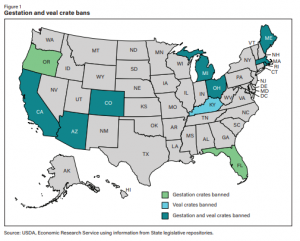Animal agriculture undoubtedly is a challenging sector of the agricultural production industry. And among the challenges of animal production is the increasing concern for farm animal welfare. While this issue has traditionally been framed as a moral or ethical issue, animal welfare concern has spread into state legislations under duress to meet public perceptions (and perhaps improve marketability) for a more sustainable, healthy, quality product.
Meanwhile, many producers and some animal scientists argue that optimal animal welfare is core to profit maximization and already being readily practiced on operations.

What exactly does animal welfare mean?
According to a recent U.S. Department of Agriculture report, defining farm animal welfare has largely defied scientific definition (the species are, after all, widely varied). However, in 2008, the World Organisation for Animal Health described good animal welfare as “a requirement that animals are healthy, comfortable, well-nourished, safe, able to express innate behaviors, and not suffering from unpleasant states like fear, pain, and distress.”
Another standard set of guidelines for defining animal welfare is the Five Freedoms, which was outlined in a 1965 Brambell Report to the British Parliament. However, the problem with these guidelines is that they’re open to interpretation depending on stakeholder priorities.
And, while the United States has passed relatively few laws about animal welfare, 14 U.S. states have passed and implemented policies addressing practices that can impact farm animal welfare since 2002. Most commonly, policies pertain to the confinement practices of livestock within the pork, egg, and veal industries. The concern, though, has largely been the far-reaching impacts these policies can and will have on interstate commerce and the industry.
As these “animal welfare” policies squeeze producers, their influence is becoming increasingly tangible on product industries, markets, and even international trade.
Where do these policy-based approaches come from?
Market-based solutions are often unsatisfactory for “stakeholders” such as vegans, vegetarians, and animal rights organizations — whose stances for animal treatment carry implications for products they may or may not consume. As a result, ballot initiatives are often used to implement State level production.
According to Humane Society of the U.S. — a national-level activist group not affiliated with local humane societies — every farm animal welfare initiative that has appeared on ballots in the last 20 years has passed.
Market demands that address animal welfare have historically focused on premium product offerings. These offerings vary, but common claims include cage-free, pasture-raised, range-free, vegetarian or grass-fed, organic, and raised without antibiotics. However, when market demand under paces the price of these products, this phenomenon has been identified as the “vote-buy gap.”
According to the USDA report, this vote-buy gap occurs “where the share of voters who support a policy is greater than those willing to take private action, such as by buying cage-free eggs (Norwood et al., 2019).”
As a result, the same policies created to improve animal welfare may impose costs exceeding consumers’ total willingness to pay for these products.

Domestic impact of livestock policies on ag markets
The most common ban has been veal crates for cattle and gestation crates for sows. So far, 11 states have passed bans on these management tools, with over 7 percent of the sow herd and 18 percent of breeding operations being directly impacted. By the end of the year, over 13 percent of U.S. operations will have some ban on veal crates.
As for laying hens, ten states have enacted policies prohibiting confinement that doesn’t meet a minimum space requirement. Nearly 25 percent of the U.S. population will purchase eggs from operations under confinement compliance restrictions by 2026.
International trade impact
Increasingly, animal welfare issues are showing up as provisions in trade agreements. While state policies do not impact shell egg imports, the report states that confinement bans on caged egg production account for 41 percent of U.S. shell egg exports. Meanwhile, imported pork from Europe and Canada is already trending towards gestation-free crate production.
What states have implemented animal welfare legislation?
Florida was the first state to address gestation crates in state policy in 2002. Nine more states have followed suit, while eight have simultaneously banned the use of veal crates in production.
Most of these states have little to do with pork production.

Meanwhile, battery cage bans and bans on the sale of products from animals produced in battery cages have extended to a small but growing proportion of U.S. egg-producing states. And, although state bans in the U.S. egg-laying flock are increasing, 83 percent of operations in the states will still be allowed to produce using battery cage systems while accounting for nearly 87 percent of all egg production. This leaves only 13 percent of total egg production in states with confinement regulations.



